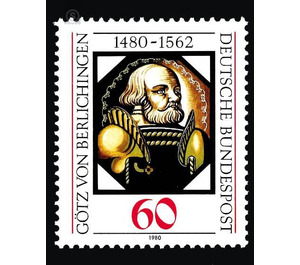500th birthday of Götz von Berlichingen - Germany / Federal Republic of Germany 1980 - 60 Pfennig
Theme: Art & Culture
| Country | Germany / Federal Republic of Germany |
| Issue Date | 1980 |
| Face Value | 60.00 |
| Color | multi-colored white |
| Perforation | K 14 |
| Printing Type | Six-color offset printing |
| Stamp Type | Postage stamp |
| Item Type | Stamp |
| Chronological Issue Number | 923 |
| Chronological Chapter | GER-BRD |
| Michel ID | BRD 1036 |
| SID | 695636 |
| In 75 Wishlists | |
When in 1773 the young Johann Wolfgang von Goethe with his work »Gottfried von Berlichingen with the iron hand, dramatized« appeared in front of an enthusiastic audience, with the unprecedented success of this Sturm und Drang play, a previously only known Reichsritter of the 16. It has suddenly come into the limelight in the 20th century and has become one of the most popular figures of the national past. In 1980, we celebrate the 500th anniversary of the historic Götz von Berlichingen, which, however, differs significantly from the idealistic Goethean hero of freedom. Born in 1480 in Jagsthausen into a wealthy Reichsritter family, after having spent "little desire for school, but much more for horseback riding", he spends youthful and apprenticeship years shaped by aristocratic tradition, first with an uncle and then with the shining Ansbacher Hof of the Margrave Friedrich von Brandenburg. Participation in the Bavarian War of Succession 1504 ends with a catastrophe for him: he loses his right hand in front of Landshut, which he can replace with an ornately manufactured iron. Services in the wake of a dark man of honor, the robber baron Thalacker Hans Massena, initiate the following ten years of virtuoso staged feuds on their own (1506 to 1516), the Gotz with the most modern means and consistent use of the formal means of feudal law as a kind of robbery businessman against such powerful opponents as the imperial cities Cologne and Nuremberg and the archbishopric Mainz leads. They justified the knight's fame as a daring "Reutersmann" before his opponents in the Swabian League, Götzens involvement in the overthrow of his former employer, the Duke Ulrich von Württemberg 1519 skillfully forfeited, with a hard hand for three and a half years in Heilbronn captivity to rest. Just released, Götz becomes his reputation as a reckless warhorse in the Peasants' War in 1525 to fate. Forced to participate by the insurgents, he manages to escape shortly before the terrible end of the elevation. But it sealed only his lot: Years of futile defense against the indictments of the Swabian League, imprisonment in Augsburg 1528 to 1530, trial and a hard Urfeehte, which is to include the nearly 50 years for the rest of his life on the label of his possessions Homberg am Neckar. Forcibly limited to the position of the aristocratic landlord, Götz, who was not broken at all, merely changed the means of action: he tirelessly intervenes to achieve real or pretended legal claims and to round off his landed property with endless processes with lords, neighbors and one's own family. After a total of four times Reichsacht around 1541 finally relieved of its original feud, he takes in 1542 and 1544 once again in two imperial wars part. In 1562, Götz, 82 years old, died in the 16th century, one of the most prominent figures of the Frankish imperial knights. He is buried in the family grave stone, the Cistercian monastery Schönthal an der Jagst. Shortly before his death, however, he wrote - at that time seldom and therefore remarkably - his colorful autobiography as a testimony of a noble self-image. It served as the source of Goethe's drama, gave him the tremendous fame that continues to this day, and made him the "most cited" figure in German history. (Text: Dr. H. Ulmschneider)
| Condition | Name | In Stock | Price | Price + Shipping | Store | |
|---|---|---|---|---|---|---|
 | Unmounted Mint ** | 500th birthday of Götz von Berlichingen - Germany / Federal Republic of Germany 1980 - 60 Pfennig | 10 | US $0.544 | US $3.80 |  FILATELIELOKET (0) FILATELIELOKET (0)Shipping US $3.25 Minimum Order US $2.72 |


